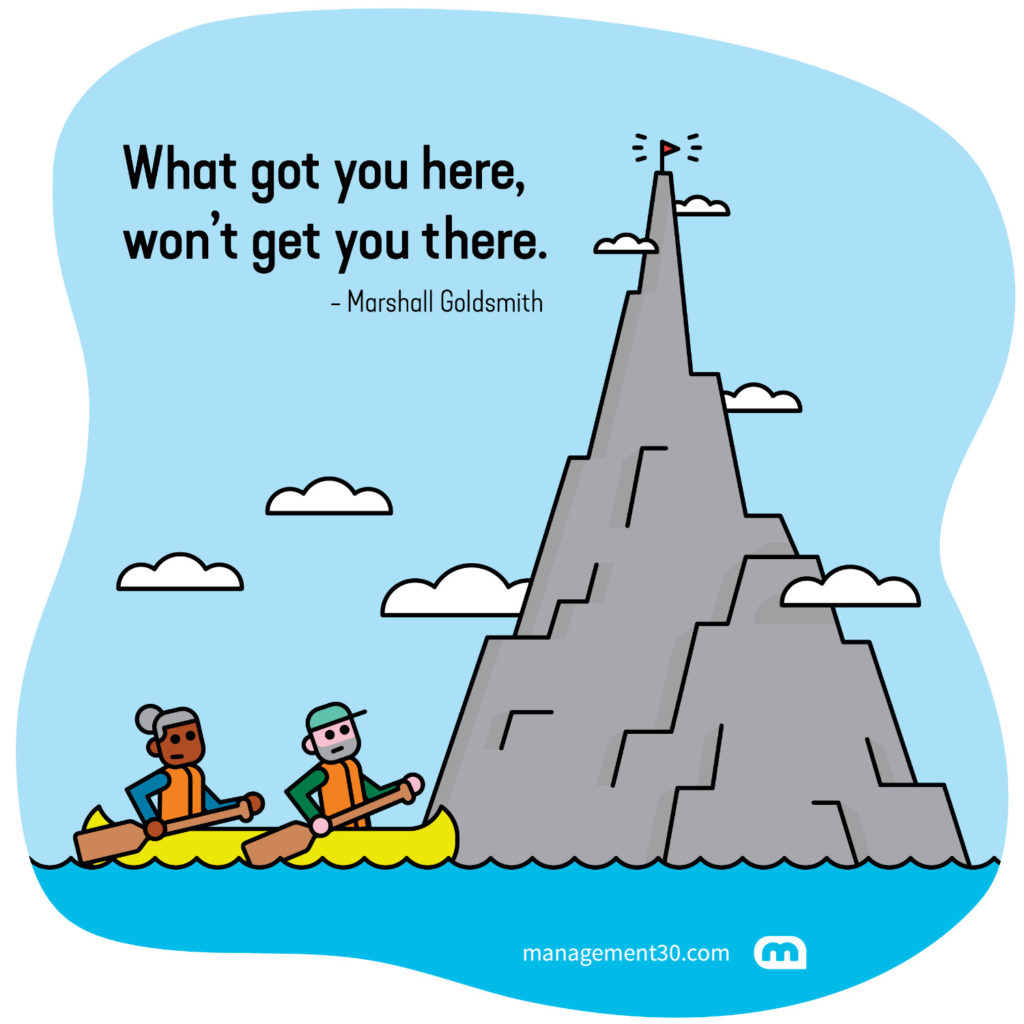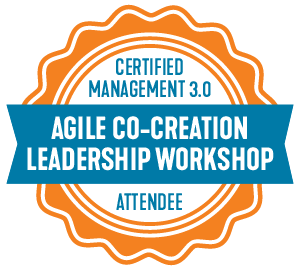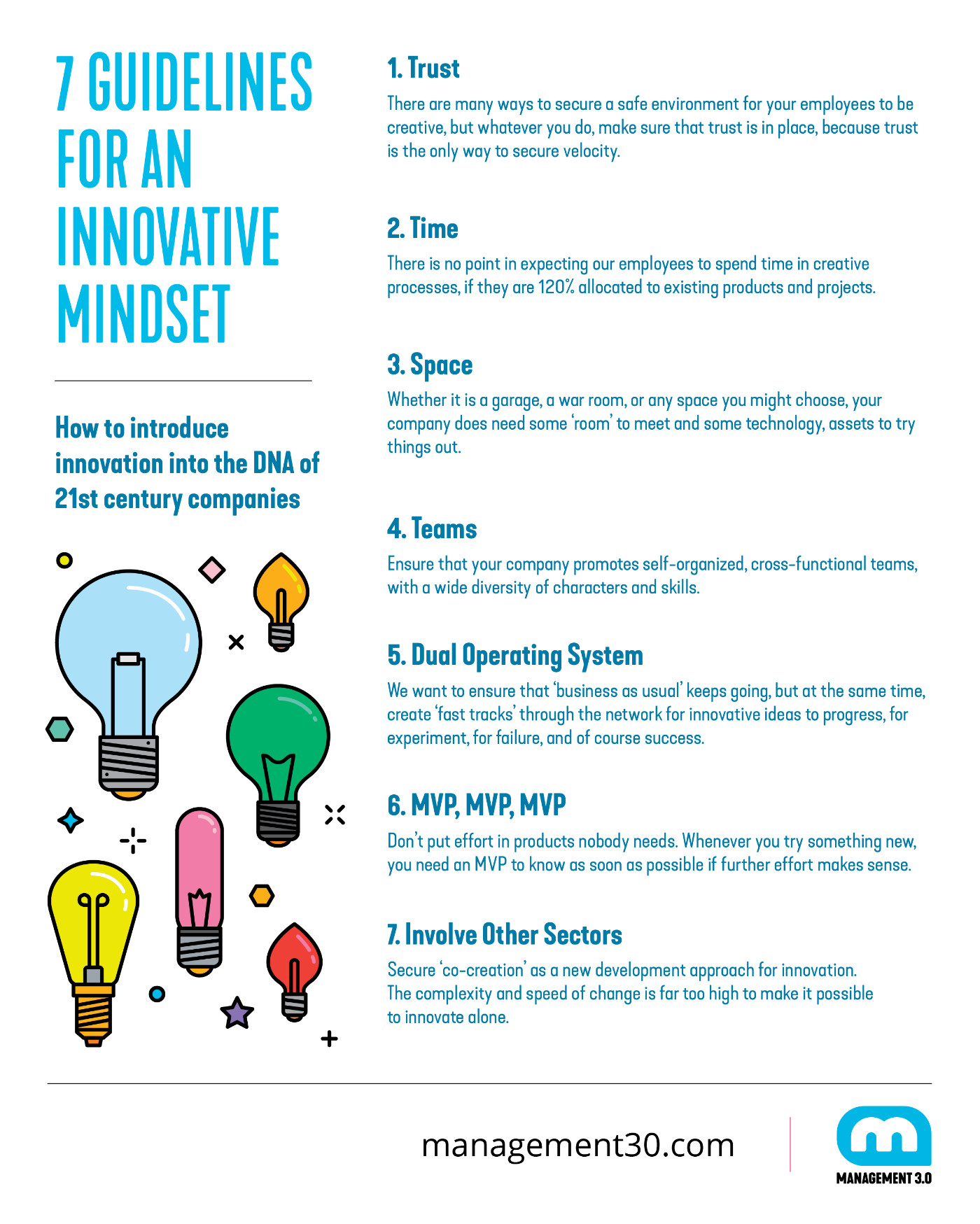One of the greatest challenges that executives and organizations face is promoting creativity and innovation within their companies, including the involvement of leaders and teams in the search for new disruptive products and services. But how? Almudena Rodriguez Pardo, a passionate agilist, Management 3.0 facilitator and business agility consultant at Rodriguez Pardo & Associates shows which steps are necessary to take to introduce innovation into the DNA of 21st century companies.
This article is based on Almudena’s session at Forward Virtual 2021, the conference by Management 3.0
“I have to finish the project first!”
“We have a deadline!”
Do these sound familiar to you?
Employees struggling with their daily work ‘don’t have time’ to take a more creative approach in their company. Despite numerous Design Thinking workshops and Hackathons, most traditional companies fail to develop a culture of innovation. Yes, innovation is failing!
We read the famous article Software Is Eating the World in 2011. Over ten years later, the new mantra is “Innovation must eat the world!”. This means, as soon as we introduce a new product to the market, we must start competing against it ourselves, the so-called ‘disrupt yourself’ behavior , because you can be sure that all your competitors will be doing so!
But, even if we are clearly aware of the dire need to promote innovation, why is this not taking place? What can we do to create an innovation mindset in the organization, starting today?
7 Guidelines for an Innovative Mindset (Innovation Management)
Based on our experiences supporting several organizations worldwide to ‘be innovative’, we have compiled some guidelines which can support you to change the attitude of each and every employee in your organization. Here are our 7 guidelines for an innovative mindset which the company Rodriguez Pardo & Associates has put together. Each step is a knock-out criteria for the following one. Which means, if you don’t meet criteria number one, there is no need to move on.
1. Innovation through Trust
As simple as that: do you trust your employees?
During the lockdown of 2020 there was a clear awareness that it is not possible to control knowledge workers. In the 21st century, controlling your employees makes no sense.
One excellent example of trust in the industry is the Finnish technological company, Futurice. Each employee has a company credit card, chooses the projects they want to work on, and have complete freedom to try new things out!
There are many ways to secure a safe environment for your employees to be creative, but whatever you do, make sure that trust is in place, because trust is the only way to secure velocity. And velocity is the main ingredient of innovation.
2. Innovation through Time
When WhatsApp was founded in 2009 by Brian Acton and Jan Koum, they had all the time in the world…they were unemployed, so they could have full dedication to their new idea. In 2014, WhatsApp was acquired by Facebook for approximately $19.3 billion USD.
There is no point in expecting our employees to spend time in creative processes, if they are 120% allocated to existing products and projects.
This is a pattern which we unfortunately observe in many companies.
There are many good examples out there in the industry showing how to allocate time to innovation, for example:
- At Ericsson Germany, we introduced Friday as ‘tryday’. On Fridays you could dedicate some hours to new products or technology.
- 3M has had the 16% concept for many years, where any employee can spend 16% of their time on whatever activities they are interested in.
- Futurice not only allows employees to dedicate 10% of their time to learning, but they also pay up to 30 hours/month for any activities and experimenting done outside of office hours, as long as it is published as open source.
- Scaled Agile Framework (SAFe) suggests dedicating a complete two week sprint every quarter to innovation activities. Not just one team, but a complete team of teams come together in a program called “Agile Release Train”. This allows about 100 people to try things out in a collaborative environment.
- Also read: Exploration Days
Which method is best? That depends on many factors. Make a choice on what you think fits best in your company, but absolutely secure time for your employees. Remember that time was the biggest asset that the founders of WhatsApp had!
3. Innovation through Space
You hear a lot of urban stories about companies starting in a garage! Well, many top worldwide companies started there!
Whether it is a garage, a war room, or any space you might choose, your company does need some ‘room’ to meet and some technology, assets, etc… to try things out.
As for today, when the world has now been working through a pandemic for almost two years, the world ‘room’ has a completely different meaning. We are facing the challenge of providing ‘digital rooms’ for innovation to take place and the assets might be stored in the cloud.
Our experience shows that enthusiastic people do find a solution! Some of our clients just started with a Zoom space and a Miro board. All management has to do is just secure the licenses!
If the employees have a safe environment and the time to use it, they will always find a solution for a digital space!
4. Innovation through Teams
One of the most attractive things about Hackathons is observing how the teams perform: we have attended several where completely new teams came together for two-day events and the most amazing ideas came out of that room!
Creative tension within a team is the best catalyst to encourage great, innovative ideas to grow. Ensure that your company promotes self-organized, cross-functional teams, with a wide diversity of characters and skills.
Our experience so far in different sectors shows that dedicated teams are the best approach for finding innovative solutions!
5. Innovation through a Dual Operating System
It was John Kotter who introduced the concept of the ‘dual operating system’ (HBR 2012). He highlighted the need for different tracks, as different products might need different velocity.
We keep seeing teams in the industry creating great ideas…but then failing to get those ideas to move at high speed through the company’s stable processes. We do need hierarchical organizations for stability, but in most of the cases, they are also slow.
We want to ensure that ‘business as usual’ keeps going, but at the same time, create ‘fast tracks’ through the network for innovative ideas to progress, for experiment, for failure, and of course success.
6. Innovation through MVP, MVP, MVP
However your fantastic idea may appear, you might be suffering from ‘product arrogance’. You and your team can be completely convinced that the idea you have in your hands is the greatest thing ever to have happened to humankind! Never forget in the heat of the creative process however, that the only thing we have are ‘assumptions’. These stay as assumptions until a customer gives feedback on whatever we are trying to create.
A Minimal Valuable Product (MVP) is not a product, this is a basic rule for innovation approaches; an MVP validates an assumption, and until it is validated, it remains an assumption.
Don’t put effort in products nobody needs. Whenever you try something new, you need an MVP to know as soon as possible if further effort makes sense.
7. Innovation through Involving Other Sectors
In 2019 Ericsson Eurolab in Germany offered startups within the local area the possibility to jointly develop 5G applications and so started a very successful collaboration with regional partners.
Furthermore, they took advantage of the proximity of the RWTH University. In 2020 Ericsson powered Europe’s largest 5G research network, the 5G Industry Campus Europe in Aachen.
Those are just two examples of how to secure ‘co-creation’ as a new development approach for innovation. The complexity and speed of change is far too high to make it possible to innovate alone.
Agile Co-Creation Leadership Workshop
Lead co-creation initiatives in your organization to foster innovation and continuous improvement for a successful and sustainable organization.
To summarize, what do you need to create an innovation mindset and to secure innovation as part of your company’s DNA?
Innovation Management Guidelines
- Trust your employees
- Given them time
- Give them physical (or digital) space
- Create teams
- Secure a dual operating system
- Support Minimal Valuable Products
- Involve and co-create with other sectors
Our personal advice: don’t wait any longer. Whatever sector you are in, innovation is eating the world and you should be prepared.
Header photo by ThisIsEngineering from Pexels




